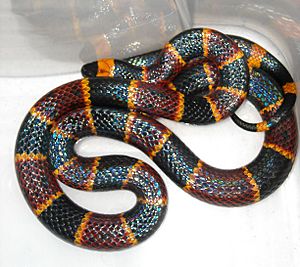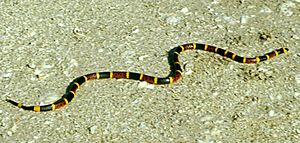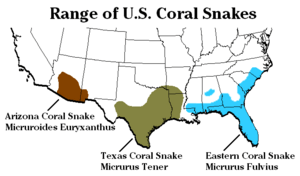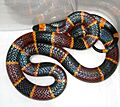Eastern coral snake facts for kids
Quick facts for kids Eastern coral snake |
|
|---|---|
 |
|
| Conservation status | |
| Scientific classification | |
| Genus: |
Micrurus
|
| Species: |
fulvius
|
| Synonyms | |
|
|
The Micrurus fulvius, also known as the eastern coral snake, is a type of highly venomous snake. It belongs to the family called Elapidae, which includes other famous venomous snakes like cobras. This snake is found only in the southeastern United States.
It's important not to confuse the eastern coral snake with other harmless snakes that look similar. These include the scarlet snake or the scarlet kingsnake. These harmless snakes are mimics, meaning they copy the look of the dangerous coral snake to scare off predators. No different types (subspecies) of the eastern coral snake are currently known.
Contents
About the Eastern Coral Snake
Eastern coral snakes are usually less than 80 centimeters (about 31 inches) long. The longest ones ever found were around 129.5 centimeters (about 51 inches). Male snakes have longer tails than females, but female snakes can grow to be longer overall.
Their scales are smooth. The snake's body has a striking pattern of wide red and black rings. These wide rings are separated by narrow yellow rings. The head of the snake is black, from its nose to just behind its eyes. The red rings often have small black specks on them.
People who live where these snakes are found often learn a rhyme to tell the difference between the venomous coral snake and harmless snakes that look similar. A common rhyme is: "Red next to black, safe from attack; red next to yellow, you're a dead fellow." This rhyme helps people know that if the red rings touch the yellow rings, the snake is venomous. If the red rings touch the black rings, it's usually a harmless snake like a kingsnake. Kingsnakes are helpful because they eat pests like rats and mice.
Remember, this rhyme only works for snakes in the United States. It cannot be used to identify snakes in other places like the Caribbean, Central, or South America. Only an expert should handle a venomous coral snake.
Other Names for the Eastern Coral Snake
The Micrurus fulvius has many common names. Some of these include the American cobra, candy-stick snake, common coral snake, coral adder, Florida coral snake, and harlequin coral snake. In Spanish, it's sometimes called serpiente-coralillo arlequín.
Where Eastern Coral Snakes Live
You can find the eastern coral snake in the southeastern United States. Their range stretches from southeastern North Carolina, south through South Carolina and Florida. It also goes west through southern Georgia, Alabama, and Mississippi to southeastern Louisiana.
Snakes found in Texas, western Louisiana, and southeastern Arkansas are now considered a different species called Micrurus tener. Eastern coral snakes can live anywhere from sea level up to about 400 meters (1,300 feet) high.
Eastern Coral Snake Habitat
Eastern coral snakes live in different types of environments. In Florida, they can be found in dry, wooded areas called tropical hammocks. They also live in open areas with pine trees and wiregrass called flatwoods.
In southern Georgia and Florida, they prefer dry places with open ground and some bushes, but not too much thick plant growth. In Mississippi, they are found on sandy ridges. In Louisiana, they live in sandy creek bottoms. In North and South Carolina, they are rarer but can be found in scrub oak forests and pine habitats near the coast.
What Eastern Coral Snakes Eat
The eastern coral snake is a predator. It eats lizards, frogs, and smaller snakes. This includes other coral snakes!
Eastern Coral Snake Reproduction
Female eastern coral snakes usually lay their eggs in June. They can lay between three and 12 eggs. These eggs typically hatch in September. When they are born, baby coral snakes are about 18 to 23 centimeters (7 to 9 inches) long.
Eastern Coral Snake Venom
The venom of the eastern coral snake is very powerful. It is a neurotoxin, which means it affects the nervous system. For small animals, the venom causes quick paralysis and stops them from breathing. In humans, a bite can cause problems like slurred speech, double vision, and muscle weakness. If not treated, it can lead to breathing failure.
Bites from eastern coral snakes are very rare. Deaths from these bites are even rarer. For example, only two deaths were recorded in the 1950s. Since an antivenin (a medicine to treat snakebites) became available in the 1960s, only one death has been reported. This happened in 2006 when a person did not get medical help after being bitten.
About 100 people are bitten by coral snakes each year in the U.S. These snakes are shy and usually don't bite unless they feel threatened. Even when they do bite, they don't always inject venom. This happens in about 40% of bites. Unlike some other venomous snakes, the eastern coral snake cannot control how much venom it injects.
Historically, the death rate from these bites was about 10–20%. Death could happen quickly, in just a few hours, or up to 26 hours after the bite. This is because even a small amount of venom can be very dangerous. Because of this, hospitals in the U.S. usually give antivenin right away for coral snake bites, even if symptoms haven't appeared yet.
Unfortunately, the companies that made the coral snake antivenin stopped producing it in 2010. This was due to it not being profitable enough. This has led to a shortage of this important medicine.
See also
 In Spanish: Serpiente de coral oriental para niños
In Spanish: Serpiente de coral oriental para niños
Images for kids





